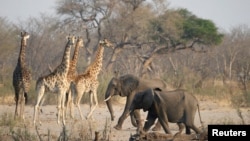Wildlife conservationists, scientists and researchers in Namibia and Southern Africa have warned of impending legal action to halt the culling of wildlife as a "mitigation strategy" to address hunger.
Hunger affects about 700,000 people in Namibia, according to the United Nations Food and Agricultural Organization — especially in rural Namibia — and it has worsened because of the drought facing the southern African region.
Officials there have started a wildlife cull — a selective killing of wild animals to save the remaining herds and habitat — and in this instance, some of the meat will be shared with communities in need.
The cull, which began August 14, targets 723 animals: 30 hippos, 60 buffalo, 50 impala, 100 blue wildebeest, 300 zebras, 83 elephants and 100 eland antelopes.
But the Namibian cabinet decision requiring the country's ministry of environment to aid the government's drought relief effort has drawn the ire of conservationists and made international headlines. It's also dividing public opinion on the timing of the decision and the logistics of culling and distributing the meat to affected communities, who are severely affected by drought.
Conservationist Izak Smit said Namibia's constitution makes provision for the protection of its natural wildlife and heritage, and the cull could have detrimental effects on the balance of wildlife in their environment.
"It's very irresponsible to do so after a drought before the rainy season when you actually need the population to procreate in order to bounce back from the drought," Smit said. "And also culling means that you do not allow nature to take its course by weeding out the weak genetic material through natural selection, from which the best genetic pool will then emerge on the other side after the draught when the rainy season again starts."
Opponents threatened legal action if Namibia authorities do not stop the cull on the grounds that it is detrimental to Namibia's natural resources, not sustainable, and not justifiable and unscientific.
Herbert Jauch, of the Economic and Social Justice Trust, said a court of law may not be the right avenue to resolve the disagreement between the government and the conservationist, which seems to be centered on the need to protect Namibia's Desert Adapted Elephants, which are a huge tourism attraction and an iconic heritage wildlife species in the country.
"Their chances are not really good," Jauch said. "If there are scientific reasons, and from what I heard so far, this is largely around the desert elephants, then that should certainly be discussed with the ministry. But I think the principle is quite understandable that in drought years you might have to reduce the population."
Romeo Muyunda, a spokesperson for Namibia's Ministry of Environment, said the cull has been blown out of proportion and Namibia's Desert Adapted Elephants are not the target of elephants earmarked for culling.
"We have millions of wildlife species in the country, approximately over 3 million animals in the country," Muyunda said. "So, 723 does not even make up 1% of the total population that we have. Another example we have is the 24,000 elephants that we have in Namibia, we are only going to cull 83 elephants, and it still doesn't make 1% of the population of elephants especially given the fact that elephants are currently the main concern here."
The animals intended for culling will be stored at various meat processing factories in the country and will be distributed through the drought relief program. It will be headed by the office of the prime minister in a joint effort to address drought and hunger in the country.
Namibia's cull has made international headlines, and conservationists are concerned it may create a harmful precedent for other African countries that do not have as successful conservation products as Namibia.





